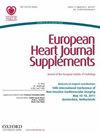心外膜脂肪组织对STEMI患者冠状动脉血栓负荷和早期结局的影响
IF 1.7
4区 医学
Q3 CARDIAC & CARDIOVASCULAR SYSTEMS
引用次数: 0
摘要
【摘要】目的探讨经皮冠状动脉介入治疗STEMI患者心外膜脂肪组织厚度(EAT)、冠状动脉血栓负荷与早期主要心血管不良事件(MACE)的关系。方法前瞻性研究纳入了2021年3月1日至2022年8月最后一天在亚历山大大学医院心内科转诊的STEMI患者(n = 80)。对患者的临床、实验室、血管造影和超声心动图资料进行了描述。观察患者在医院或30天随访期间是否发生任何重大心血管不良事件。特别需要注意的是,在舒张末期胸骨旁长、短轴位上垂直于右心室自由壁测量EAT作为心肌和脏心外膜之间的无回声空间,以及血栓负荷的血管造影评估,评分如下:0(无血栓),1(可能有血栓),2(明确有血栓);0.5×参考血管直径),3(明确血栓0.5 ~ 2x参考血管直径),4(明确血栓±2x参考血管直径),5(血管完全闭塞)。根据血栓分级将患者分为低血栓负担组(0 ~ 3级)和高血栓负担组(4、5级)。结果低血栓负担组25例,高血栓负担组55例。两组在年龄、性别、吸烟和药物依赖状况、冠心病家族史、糖尿病、高血压、总胆固醇、甘油三酯、LDL-C和HDL-C、平均壁运动评分和壁运动评分指数等方面均无差异。高敏感性肌钙蛋白I和肌酸激酶MB平均水平在血栓负荷低组较高,差异有统计学意义(P = 0.025)和(P = 0.032)。两组间球囊预扩张率差异有统计学意义(P = 0.006)。两组间血栓吸入、罪魁祸首血管球囊扩张、GpIIb/IIIa抑制剂和仅一个支架的差异不显著。进行受试者工作特征曲线分析,确定EAT的截止值,以预测是否存在高血栓负荷,并在P <0.05. 厚度为2.48 mm的EAT预测高血栓负荷的敏感性为74.55%,特异性为72.0%。通过单变量分析分析高血栓负荷的预测因子,发现EAT、腰围、体重、体重指数和球囊预扩张是高血栓负荷的独立预测因子。多变量分析显示EAT和球囊预扩张是高血栓负荷的独立预测因子。血栓负荷低组与血栓负荷高组随访30天总MACE差异无统计学意义。根据心外膜脂肪组织厚度,MACE患者与非MACE患者之间的差异无统计学意义。结论EAT是STEMI患者冠状动脉血栓负荷的独立预测因子。一个作者的视频,伴随着这个摘要可在https://academic.oup.com/eurheartjsupp。请点击“更多内容”旁边的箭头,然后点击“作者视频”。本文章由计算机程序翻译,如有差异,请以英文原文为准。
Impact of epicardial adipose tissue on coronary arteries thrombus burden and early outcomes in STEMI patients
Abstract Aim Evaluation the relationship between the epicardial adipose tissue thickness (EAT), the coronary arteries thrombus burden and the early major adverse cardiovascular events (MACE) in patients presented with STEMI undergoing primary percutaneous coronary intervention. Method The study was prospective and included patients (n = 80) who were referred to the cardiology department in Alexandria University Hospitals with STEMI between the 1st of March 2021 and the last day of August 2022. Patient clinical, laboratory, angiographic and echocardiographic data were described. Patients were put under observation to detect the occurrence of any major adverse cardiovascular events either in hospital or during a period of 30 days follow up. Special concerns for measuring EAT as an echo free space between the myocardium and visceral epicardial and measured perpendicular to the free wall of the right ventricle in parasternal long and short axis views at end diastole and angiographic assessment of thrombus burden was scored as follows: 0 (no thrombus), 1 (possible thrombus), 2 (definite thrombus < 0.5× reference vessel diameter), 3 (definite thrombus 0.5–2× reference vessel diameter), 4 (definite thrombus >2× reference vessel diameter), and 5 (complete vessel occlusion). According to thrombus grade the patients were grouped as low thrombus burden (grades 0–3) and high thrombus burden (grades 4 and 5). Results 25 subjects were in the low thrombus burden group and 55 in the high thrombus burden group. There were no differences in the two groups for age, sex, smoking and drug addiction status, family history of coronary artery disease, diabetes mellitus, hypertension, and total cholesterol, triglyceride, LDL-C and HDL-C, The mean Wall motion score and Wall motion score index. The means levels of high sensitivity troponin I and Creatine Kinase MB are measured higher in the low thrombus burden group with statistically significant difference (P = 0.025) and (P = 0.032). Balloon predilation was statistically significant difference between the two groups (P = 0.006). Thrombus’ aspiration, balloon post dilation of the culprit vessel, GpIIb/IIIa inhibitors, and one stent only were insignificant difference between the two groups. The receiver operating characteristic curve analysis was undergone to determine the cutoff value of EAT to predict the presence of high thrombus burden setting a significance level at P < 0.05. The thickness of 2.48 mm for EAT has 74.55% sensitivity and 72.0% specificity for prediction of the high thrombus burden. The predictors of the high thrombus burden were analyzed by univariate analysis shows EAT, the waist circumference, Wight, the body mass index, and balloon predilation were found as an independent predictors of high thrombus burden. The multivariate analysis shows EAT and balloon predilation were found as an independent predictors of high thrombus burden. The overall MACE at 30 day follows up has statistically insignificant difference between low and high thrombus burden groups. There was statistically insignificant difference between patients with or without MACE according to epicardial adipose tissue thickness. Conclusion EAT was an independent predictor of coronary thrombus burden in STEMI patients. Additional Content An author video to accompany this abstract is available on https://academic.oup.com/eurheartjsupp. Please click on the arrow next to ‘More Content’ and then click on ‘Author videos’.
求助全文
通过发布文献求助,成功后即可免费获取论文全文。
去求助
来源期刊

European Heart Journal Supplements
医学-心血管系统
CiteScore
3.00
自引率
0.00%
发文量
575
审稿时长
12 months
期刊介绍:
The European Heart Journal Supplements (EHJs) is a long standing member of the ESC Journal Family that serves as a publication medium for supplemental issues of the flagship European Heart Journal. Traditionally EHJs published a broad range of articles from symposia to special issues on specific topics of interest.
The Editor-in-Chief, Professor Roberto Ferrari, together with his team of eminent Associate Editors: Professor Francisco Fernández-Avilés, Professors Jeroen Bax, Michael Böhm, Frank Ruschitzka, and Thomas Lüscher from the European Heart Journal, has implemented a change of focus for the journal. This entirely refreshed version of the European Heart Journal Supplements now bears the subtitle the Heart of the Matter to give recognition to the focus the journal now has.
The EHJs – the Heart of the Matter intends to offer a dedicated, scientific space for the ESC, Institutions, National and Affiliate Societies, Associations, Working Groups and Councils to disseminate their important successes globally.
 求助内容:
求助内容: 应助结果提醒方式:
应助结果提醒方式:


